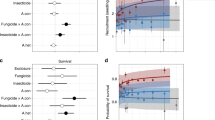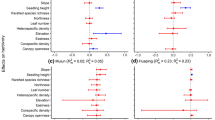Abstract
Herbivores and pathogens with acute host specificity may promote high tree diversity in tropical forests by causing distance- and density-dependent mortality of seedlings, but evidence is scarce. Although Lepidoptera larvae are the most abundant and host-specific guild of herbivores in these forests, their impact upon seedling distributions remains largely unknown. A firm test of the mechanism underpinning the Janzen–Connell hypothesis is difficult, even for a single tree species, because it requires more than just manipulating seeds and seedlings and recording their fates. Experimental tests require: (1) an insect herbivore that is identified and highly specialised, (2) linkage to an in situ measure (or prevention) of herbivory, and (3) evaluation and confirmation among many conspecific adult trees across years. Here we present experimental evidence for a spatially explicit interaction between newly germinating seedlings of a Neotropical emergent tree, big-leaf mahogany (Swietenia macrophylla, Meliaceae), and caterpillars of a noctuid moth (Steniscadia poliophaea). In the understory of a southeastern Amazon forest, the proportion of attacks, leaf area lost, and seedling mortality due to this specialised herbivore peaked near Swietenia trees, but declined significantly with increasing distance from mature fruiting trees, as predicted by the Janzen–Connell hypothesis. We conclude that long-distance dispersal events (>50 m) provided an early survival advantage for Swietenia seedlings, and propose that the role of larval Lepidoptera as Janzen–Connell vectors may be underappreciated in tropical forests.



Similar content being viewed by others
References
Aide TM (1993) Patterns of leaf development and herbivory in a tropical understory community. Ecology 74:455–466
Augspurger CK (1984) Seedling survival of tropical tree species–interactions of dispersal distance, light-gaps and pathogens. Ecology 65:1705–1712
Barone JA (1998) Host-specificity of folivorous insects in a moist tropical forest. J Anim Ecol 67:400–409
Bell T, Freckleton RP, Lewis OT (2006) Plant pathogens drive density-dependent seedling mortality in a tropical tree. Ecol Lett 9:569–574
Bernays EA (2001) Neural limitations of phytophagous insects: implications for diet breadth and affiliation. Annu Rev Entomol 46:703–727
Blundell AG, Peart DR (1998) Distance-dependence in herbivory and foliar condition for juvenile Shorea trees in Bornean dipterocarp rain forest. Oecologia 117:151–160
Carson WP, Anderson JT, Leigh EG, Schnitzer SA (2008) Challenges associated with testing and falsifying the Janzen-Connell hypothesis: a review and critique. In: Carson WP, Schnitzer SA (eds) Tropical Forest Community Ecology. Wiley-Blackwell, Oxford, pp 210–241
Cates RG (1980) Feeding patterns of monophagous, oligophagous, and polyphagous insect herbivores: the effect of resource abundance and plant chemistry. Oecologia 46:22–31
Clark DB, Clark DA (1985) Seedling dynamics of a tropical tree: impacts of herbivory and meristem damage. Ecology 66:1884–1892
Coley PD (1983) Herbivory and defensive characteristics of tree species in a lowland tropical forest. Ecol Monogr 53:209–233
Coley PD, Barone JA (1996) Herbivory and plant defenses in tropical forests. Annu Rev Ecol Syst 27:305–335
Connell JH (1971) On the role of natural enemies in preventing competitive exclusion in some marine animals and in rain forest trees. In: Den Boer PJ, Gradwell G (eds) Dynamics of populations. Centre for Agricultural Publication and Documentation, Wageningen, pp 298–312
Dyer LA, Singer MS, Lill TJ, Stireman JO, Gentry GL, Marquis RJ, Ricklefs RE, Greeney HF, Wagner DL, Morais HC, Diniz IR, Kursar TA, Coley PD (2007) Host-specificity of Lepidoptera in tropical and temperate forests. Nature 448:696–700
Freckleton RP, Lewis OT (2006) Pathogens, density-dependence and the coexistence of tropical trees. Proc R Soc B 273:2909–2916
Grogan JE (2001) Bigleaf mahogany (Swietenia macrophylla King) in southeast Pará, Brazil: a life history study with management guidelines for sustained production from natural forests. PhD thesis, Yale University, New Haven
Grogan J, Galvão J (2006a) Factors limiting post-logging seedling regeneration by big-leaf mahogany (Swietenia macrophylla) in southeastern Amazonia, Brazil, and implications for sustainable management. Biotropica 38:219–228
Grogan J, Galvão J (2006b) Physiographic and floristic gradients across topography in transitional seasonally dry evergreen forests of southeast Pará, Brazil. Acta Amazon 36:483–496
Grogan J, Landis RM, Ashton MS, Galvão J (2005) Growth response by big-leaf mahogany (Swietenia macrophylla) advance seedling regeneration to overhead canopy release in southeast Pará Brazil. For Ecol Manage 204:399–412
Harms KE, Wright SJ, Calderon O, Hernandez A, Herre EA (2000) Pervasive density-dependent recruitment enhances seedling diversity in a tropical forest. Nature 404:493–495
Janzen DH (1970) Herbivores and the number of tree species in tropical forests. Am Nat 104:501–528
Janzen DH (1981) Pattern of herbivory in a tropical deciduous forest. Biotropica 13:271–282
Janzen DH (1988) Ecological characterization of a Costa Rican dry forest caterpillar fauna. Biotropica 20:120–135
Kitajima K (2003) Impact of cotyledon and leaf removal on seedling survival in three tree species with contrasting cotyledon functions. Biotropica 35:429–434
Kursar TA, Wolfe BT, Epps MJ, Coley PD (2006) Food quality, competition and parasitism influence feeding preference in a neotropical lepidopteran. Ecology 87:3058–3069
Lamb FB (1966) Mahogany of tropical America: its ecology and management. University of Michigan Press, Ann Arbor
Massey FP, Massey K, Press MC, Hartley SE (2006) Neighbourhood composition determines growth, architecture and herbivory in tropical rain forest tree seedlings. J Ecol 94:646–655
Mayhew JE, Newton AC (1998) The silviculture of mahogany. CAB International, Wallingford
Morris MH, Negreros-Castillo P, Mize C (2000) Sowing date, shade and irrigation affect big-leaf mahogany (Swietenia macrophylla King). For Ecol Manage 132:173–181
Muller-Landau HC, Levin SA, Keymer JE (2003) Theoretical perspectives on evolution of long-distance dispersal and the example of specialised pests. Ecology 84:1957–1967
Nair KSS (2007) Tropical forest insect pests: ecology, impact and management. Cambridge University Press, Cambridge
Nathan R, Casagrandi R (2004) A simple mechanistic model of seed dispersal, predation and plant establishment: Janzen-Connell and beyond. J Ecol 92:733–746
Norghauer JM, Malcolm JR, Zimmerman BL (2006a) Juvenile mortality and attacks by a specialist herbivore increase with conspecific adult basal area of Amazonian Swietenia macrophylla (Meliaceae). J Trop Ecol 22:451–460
Norghauer JM, Malcolm JR, Zimmerman BL (2006b) An experimental test of density- and distant-dependent recruitment of mahogany (Swietenia macrophylla) in southeastern Amazonia. Oecologia 148:437–446
Norghauer JM, Malcolm JR, Zimmerman BL (2008) Canopy cover mediates interactions between a specialist caterpillar and seedlings of a tropical tree. J Ecol 96:103–113
Novotny V, Basset Y, Miller SE, Weiblen GD, Bremer B, Cizek L, Drozd P (2002) Low host specificity of herbivorous insects in a tropical forest. Nature 416:841–844
Novotny V, Miller SE, Leps J, Basset Y, Bitto D, Janda M, Hulcr J, Damas K, Weiblen GD (2004) No tree an island: the plant–caterpillar food web of a secondary rain forest in New Guinea. Ecol Lett 7:1090–1100
Quinn GP, Keough MJ (2002) Experimental design and data analysis for biologists. Cambridge University Press, New York
Richards PW (1996) The tropical rain forest. An ecological study, 2nd edn. Cambridge University Press, Cambridge
Ridley HN (1930) Dispersal of plants throughout the world. Reeve, Ashford
Schoovern LM, van Loon JJA, Dicke M (2005) Insect–plant biology, 2nd edn. Oxford University Press, Oxford
Schupp EW (1992) The Janzen-Connell model for tropical tree diversity—population implications and the importance of spatial scale. Am Nat 140:526–530
Snook LK, Cámara-Cabrales L, Kelty MJ (2005) Six years of fruit production by mahogany trees (Swietenia macrophylla King): patterns of variation and implications for sustainability. For Ecol Manage 206:221–235
Sullivan JJ (2003) Density-dependent shoot-borer herbivory increases the age of first reproduction and mortality of neotropical tree saplings. Oecologia 136:96–106
Turner IM (2001) The ecology of trees in the tropical rain forest. Cambridge University Press, Cambridge
Vander Wall SB, Kuhn MK, Beck MJ (2005) Seed removal, seed predation, and secondary dispersal. Ecology 86:801–806
Webb CO, Peart DR (1999) Seedling density-dependence promotes co-existence of Bornean rain forest trees. Ecology 80:2006–2017
Wright SJ (2002) Plant diversity in tropical forests: a review of mechanisms of species co-existence. Oecologia 130:1–14
Zimmerman JK, Thompson J, Brokaw N (2008) Large tropical forest dynamics plots: testing explanations for the maintenance of species diversity. In: Carson WP, Schnitzer SA (eds) Tropical forest community ecology. Wiley-Blackwell, Oxford, pp 89–117
Acknowledgments
We thank the Brazilian government and the Kayapó community of A’ukre for research permission, as well as Conservation International—Brazil for logistical support in the field. We are grateful for early helpful discussions with A. A. Agrawal, S. C. Thomas, S. Smith and C. Nock; and to J. Solorzano-Filho for formatting the photos in Fig. 1. Funding was kindly provided by a doctoral scholarship to J. M. N. from Le Fonds Québécois de la Recherche sur la Nature et Technologies (Government of Québec, Canada), a grant from the Donner Foundation Canada, and a grant to J. R. M. from the Natural Sciences and Engineering Research Council of Canada. Research was done in accordance with the laws of Brazil.
Author information
Authors and Affiliations
Corresponding author
Additional information
Communicated by Jacqui Shykoff.
Rights and permissions
About this article
Cite this article
Norghauer, J.M., Grogan, J., Malcolm, J.R. et al. Long-distance dispersal helps germinating mahogany seedlings escape defoliation by a specialist caterpillar. Oecologia 162, 405–412 (2010). https://doi.org/10.1007/s00442-009-1476-9
Received:
Accepted:
Published:
Issue Date:
DOI: https://doi.org/10.1007/s00442-009-1476-9




